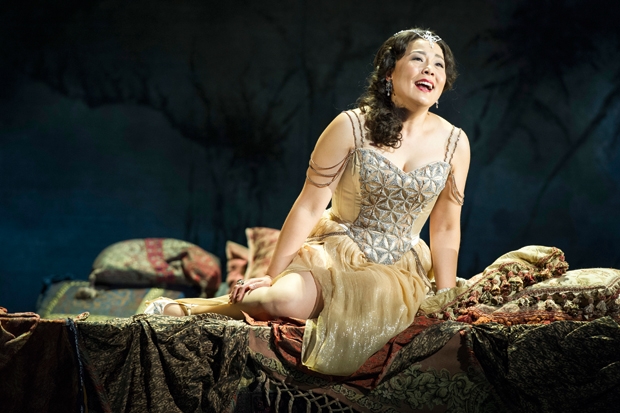Virtue, hide thyself! The Coronation of Poppea opens with a warning and closes with a love duet for a concubine and a psychopath, their union celebrated in sinuous melismas over a blameless passacaglia. First performed in 1643, Monteverdi’s final opera is all about talking dirty and talking tough. Seductions, threats, boasts and betrayals are snapped, spat, stuttered and smooched over harmonies that pinch and squeeze like a premium-rate sex-line. Does it work in English? Yes and no. There are casualties in Tim Albery’s slick, vicious Opera North production, some historical, some poetic, some musical. In Laurence Cummings’s hybrid edition, drawn from the Venice and Naples scores, transpositions and cuts proliferate. Yet the emperor’s lust for Poppea is palpable to a degree rarely felt in the opera house. This is just as well, for Monteverdi’s toxic hero and heroine not only show us their lovemaking but review it for us, detailing the kisses and caresses of the previous night with shameless, self-congratulatory pleasure.
Virtù, Fortuna and Amore wear modern dress, the first a dowdy academic (Claire Pascoe), the second an executive in hooker heels (Ciara Hendrick), the third a flint-eyed teenage boy in high-tops and snapback hat (the brilliant Emilie Renard). Nero (James Laing) and his entourage saunter about in 1960s tailoring, madmen dressed after Mad Men. There are tweeds for Seneca (James Creswell), shoulder holsters for the hitmen Lucano and Liberto (Nicholas Sharratt and Daniel Norman), and a chiffon dressing-gown trimmed with fur for Sandra Piques Eddy’s magnetic Poppea. The pit is empty. Two violins, a lirone and a harpsichord sit to one side of the stage; two theorbos, a harp and a second harpsichord on the other. Led from the keyboard, Cummings’s orchestration is organic, with the only distinct match of particular instruments to a particular voice — a honeyed brew of lirone, lutes and harp — reserved for Poppea. The tiled walls of Hannah Clark’s set reflect the sound. Co-ordination is achieved on the breath and with the ears. It follows that the degree of eye-contact between the singers is exemplary, as is their physical freedom.

Piques Eddy dominates, a compelling and seductive actress and singer. Half of the fascination we have with Poppea’s ascent to the throne is in seeing her reaction as her insinuations are translated into death sentences. As any second wife knows, what happens to the first wife might happen to them too. Seasoned opera lovers will be on the alert for carnage from the first appearance of a jug of tomato juice, as Hendrick’s Valletto mixes a Bloody Mary for Catherine Hopper’s embittered Ottavia. Sure enough, the dining table becomes a mortuary slab, draped with the bodies of Ottavia, Ottone (Christopher Ainslie) and Drusilla (Katherine Manley) and liberally dressed with passata by Laing. Crude as Albery’s translation is, every word is clear, the singing stylish, though the transpositions compromise Ainslie’s sweet, supple counter-tenor. The final number, ‘Pur ti miro’ (Now I see you), provides the most memorable sequence of images and sounds, as Poppea and Nero sit at either end of the long table, singing to each other (not us), rising, embracing, making love and separating again. It’s a duet of phenomenal pheromonal intensity. Look hard (how can one not), and you can see a shift in the balance of power and the terror in Poppea’s eyes.
Only one god is invoked in La traviata: the stern, bearded patriarch of the 19th century. Updated to the 1880s, with references to Gustave Eiffel’s ferronnerie and Robert Koch’s discovery of the tubercle bacillus in Madeleine Boyd’s designs, Alessandro Talevi’s staging works hard to conjure a city intoxicated by modernity. As the divisi violins of the opening bars loiter wanly in the air, we see Violetta Valéry gazing up at the moon, its surface clouded with the mycobacteria that will kill her. Talevi’s strongest work is not in the petri dish nor in the bronchoscopy video (yuck) that follows. Neither is it in the flamboyant charade of Mérimée’s Carmen (as opposed to Bizet’s) that is staged at Flora’s party in Act II. It is instead in his direction of Hye-Youn Lee, whose small, tough Violetta embodies brittle coquetry, pride, shame and sickness but lacks the ideal shimmer in her voice. Talevi highlights the breathlessness and feverishness in Verdi’s score, adding a second tuberculosis victim to the throng of dandies, pimps and prostitutes. In the pit, conductor Gianluca Marciano could find a better balance between rhythmic details and the dramatic arc. Ji-Min Park’s baby-faced Alfredo is sympathetically drawn, if stiffly sung. The choreography of Violetta’s encounter with Germont (an excellent Roland Wood) is fascinating. But while Verdi’s fury at the hypocrisy of his age is made clear, La traviata needs tenderness too.






Comments